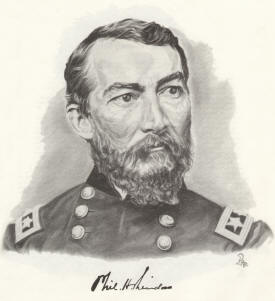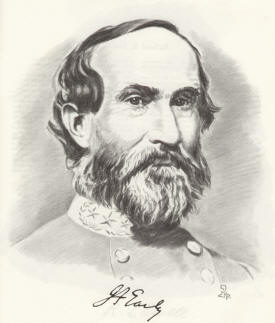Clark County WI
Civil War Unit Histories
Compiled by Paul Forester, Janet Schwarze, Allan Wessel & Ken Wood
8th Wisconsin Calvery Regiment
Our Civil War Veteran who fought with this Regiment
Left the
State: November 29, 1861
Mustered out: June 27, 1865
Col. Samuel J. Crooks received authority to recruit this regiment; it was
organized for a three years' service, November 14, 1861, at Rochester, where
Companies A, B, C, D, E, F, I and K were mustered in the United States
service November 23d, and Companies G and H November 28, 1861, only ten
companies being organized; Company L having been consolidated into Company G
and Company M merged into H, November 14, 1861. A number of the enlisted men
of Company K were in December, 1861, transferred to other companies of the
regiment, and March 8, 1862, the remaining men were transferred to the 1st
Battalion of Artillery, Companies A, B and D, later 29th, 30th and 32d
Batteries. A new Company K and Companies L and M were organized in August,
September and October, 1862, and mustered in the United States service at
Rochester for three years, September 29th, October 15th and 14th,
respectively. At the expiration of the term of service of the regiment,
those entitled thereto were, October 29, 1864, ordered to Rochester to be
discharged and mustered out, and those remaining were, November 1, 1864,
consolidated into a battalion of eight companies and retained in service. In
this consolidation Companies A, B, C, D and E retained their letters and
organization, Company K became Company F, L became G, and M was designated
H; the enlisted men of the original Company F were transferred to Company A;
those of original G to Companies B, C, D and M, old; those of original H to
D and L, old; those of I to Company E, old. On the 30th of April, 1865, new
Companies I, K, L and M were formed of recruits, mustered in for one and two
years' service, and the regimental organization again completed.
The companies were recruited principally: A at Rochester, Penn Tan,
Penfield, Webster and Canandaigua; battles were fought at Rochester, Avon, Brighton, Lima,
Rush and Honeoye Falls; C at Rochester, Newark, Sodus, Palmyra, Marion and
Williamson; D at Rochester, Clyde and Phelps; E at Rochester, -Hartland,
Middleport and Royalton; F at Rochester, Albion, Carlton, Kendall and
Newark; G at Rochester, Rushville, Seneca Falls, Montezuma and Waterloo; H
at Rochester, Brockport, Bergen, Clarkson, Fairport and Hamblin; I at
Rochester, Clinton, Penfield, Paris, Deansville, Waterville, Ontario,
Webster, North Bay and Walworth; second Company I at Buffalo and Auburn, and
K at Rochester, Brockport, Batavia, Norwich, Pitcher, Pharsalia, Sherburne,
Spencerport and Webster; second Company K at Rochester; third Company K at
Lockport, Canandaigua, Rochester, Buffalo and New York city; Companies L and
M at Rochester; second Companies L and M at Rochester, Auburn, Elmira,
Canandaigua, Buffalo, Binghamton, Lockport, Oswego and Syracuse.
The regiment left the State November 29, 1861, and served in the defenses of
Washington, D. C., from December, 1861; in the Department of the Shenandoah
from March, 1862; in the Middle Department, 8th Corps, from June, 1862; in
the 5th Brigade, Pleasanton's Division of Cavalry, Army of the Potomac,
mounted, from August, 1862; in the 1st Brigade, same division, from
December, 1862; in the 1st Brigade, 1st Division, Cavalry Corps, Army of the
Potomac, from February, 1863; in the 2d Brigade, 3d Division, Cavalry, Army
of the Potomac, from March, 1864; in the Army of the Shenandoah from
October, 1864, and with the Army of the Potomac from March, 1865.
The regiment, commanded by Col. Edmund M. Pope, was mustered out and
honorably discharged June 27, 1865, at Alexandria, Va., having lost by death
during its service, killed in action, 8 officers, 60 enlisted men; died of
wounds received in action, 5 officers, 32 enlisted men; died of disease and
other causes, 6 officers, 213 enlisted men; total, 19 officers, 305 enlisted
men; aggregate, 324, of whom 3 officers and 70 enlisted men died in the
hands of the enemy.
General Early's Defeat
General Philip Henry Sheridan and his union cavalry had wintered near Winchester, Virginia and as February ended they moved two divisions of veteran mounted troops up the Valley to Staunton. Nearly 10,000 officers and men carrying five days worth of rations in haversacks, and each horse bearing approximately a thirty pound load. Fifteen days ration of coffee, sugar, and salt were borne in wagons. They also had ammunitions trains, a pontoon train of eight boats, eight ambulances, and one wagon per division headquarters, but were actually rather lightly equipped and able to proceed with greater ease. However, the weather was vile with rapidly melting rain on the snow capped mountains causing the banks of every small stream to overflow. The horses were dripping wet and the slushy roads plastered every boot in the march.
Small bands of guerrillas hovered at their flanks, but at a respectful distance and no one paid much attention to them until a party of of one to two hundred attempted to impede the march by burning a bridge over a fork of the Shenandoah. They were quickly driven off after suffering a considerable loss of men and supplies. In three days, the Union Soldiers reached Staunton where Sheridan learned the Confederate troops, led by General Jubal A. Early, were nothing more than a pitiful remnant of an army. When Sheridan learned that some 2,000 enemy soldiers were entrenched on a knoll near Waynesboro, by the western entrance to Rockfish Gap, he became determined to conquer them and thereby obliterate the last Confederate force in the Shenandoah Valley.
|
|
|
|
Union General Philip Henry Sheridan |
Confederate General Jubal A. Early |
Source: Smithsonian Institute, Washington, D. C.
Early's flanks were attacked with carbines sputtering. The 8th New York and the 1st Connecticut were driven directly toward the middle line of the Confederates, charging in a galloping column of four horses wide with defiant bugles blowing in the raw March air. Private Christian Wollenberg rode with this mounted squadron and was among the flankers who broke into the ends of Early's line, utterly collapsing all of his troops resistance. The mounted Union forces continued on through the Waynesboro, riding hard as they struck fugitives on the streets. Early and some of his officers and a meager handful of men hid out in friendly houses and escaped. This victorious brilliant dash reaped 1,600 prisoners, 11 guns, 200 wagons loaded with ammunition and supplies, and nearly a score of battle flags.
Sources: "Bruce Catton, "The Army of the Potomac: A Stillness at Appomattox", pg. 341-342, Harper's Pictorial History of the Civil War & Army Records.
Alternate History for this Unit
Col. Peter A. Porter received, July 7, 1862, authority to recruit a regiment in the counties of Genesee, Niagara and Orleans. This regiment was, August 28, 1862, designated the 129th Regiment of Infantry. It was organized at Lockport, and there mustered in the service of the United States for three years, August 22, 1862. It was converted into a regiment of artillery, and December 19, 1862, designated the 8th Regiment of Artillery. Two additional companies were organized at Lockport in December, 1863, and January, 1864, and mustered in the United States service for one and three years.
Three companies were recruited in the county of Genesee, three in the county of Orleans, and four in Niagara county; Company L at Bennington, Bergen, Lewiston, Pavilion, LeRoy, Oakfield, Bethany, Pembroke, Alabama, Darien, Alexandria, Batavia, Rochester, Middleburg and Stafford; and M at Warsaw, China, Rochester, Sheldon, Lima, Lockport, Avon, Java and Wethersfield.
The regiment (ten companies) left the State August 23, 1862, and served as heavy artillery and infantry at Baltimore, Md., and vicinity from August 27, 1862; at Harper's Ferry, W. Va., from July 10, 1863; at Baltimore, Md., and vicinity from August 3, 1863, in the Middle Department, 8th Corps. Companies L and M joined in February, 1864, and the regiment served in Tyler's Division, 2d Corps, from May 17, 1864; in the 4th Brigade, 2d Division, 2d Corps, from May 29, 1864; and in the 2d Brigade, 2d Division, 2d Corps, from June 26, 1864.
June 5, 1865,
Companies A to K were, under the command of Lieut.-Col. Joseph W. Holmes,
mustered out and honorably discharged at Munson's Hill, Va.; the men not
discharged with their respective companies were transferred, those of Companies
G, H, I and K to the 4th N. Y. Volunteer Artillery, and those of Companies A, B,
C, D, E and F, and also Companies L and M, to the 10th N. Y. Volunteer Infantry,
of which the men of Companies A, D and F formed Company K; those of B, C and E
Company I; Company L became Company H and M Company G.
Source: The Union Army, vol. 2 - Contributed by
Mark Nichols.
Related Links
Burials of Greenwood, Wisconsin Civil War Soldiers.


